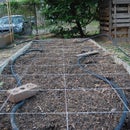Introduction: Berlese Funnel
Information
A berlese funnel is a device that is used to extract insects from soil and litter samples. It was invented by Antonio Berlese and later improved. by Tullgren. Basically, it uses a heat source (in this case a light bulb) to dry the sample, forcing the insects through a screen and into a jar of preserving fluid. It is a useful tool for attaining cryptic species that would otherwise evade even the most avid collector.
Step 1: Materials
Materials; These are the materials that I used, but I just used what I had around. Please feel free to take the idea here and modify it.
-1 gallon tractor funnel; I ordered mine through ace hardware for about $16
-Reflector light fixture (That's the only thing I know to call it. I got mine at tractor supply for brooding chicks and quail.) It should have a diameter equal or greater than that of the funnel, but if you find one with equal diameter it looks cleaner. The funnel and light used here both measure about 10".
-cat litter bucket; The funnel sat well in this bucket, so I used it. Basically, you just need to suspend the funnel above the killing jar.
- 1/4" wire mesh cut to fit snugly into the funnel.
-Mid sized jar; Nothing Special.
-Clothes pin
-Some flexible wire; a few inches will suffice.
-light bulb; I'm not sure what the best wattage of bulb is best here, so experiment. Just don't leave it alone and accidentally catch your house on fire.
Step 2: Putting It Together.
There are a few modifications that need to be made so that the pieces fit together. First, I cut one side of the bucket out so that the collection jar could be removed without disassembling the entire thing. Next, I punched a hole in the funnel and ran the wire through it to create a rudimentary hinge. FInally, I cut the tip of the clothespin off, so that it could clamp the light fixture to the funnel. The funnel was then placed in the bucket and the jar under the funnel. The jar can be empty to collect live specimens, or have a few inches of rubbing alcohol in the bottom.
Step 3: Results
I have only tested it once, but the results were quite good. It was still cold, so I used some active compost as the litter, since it was warm enough to contain insects. From just a couple handfuls of compost I collected countless springtails as well as a number of larvae. For more info and results, check out www.blueegg.wordpress.com











